Innovative Kitchen Countertop Organization Ideas
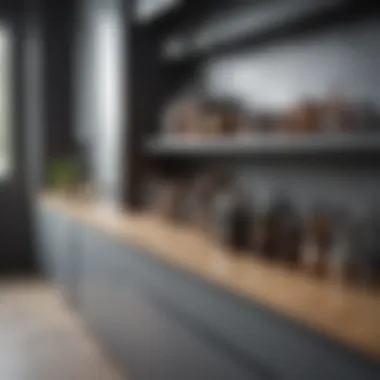

Intro
Kitchen countertops are often the heart of the home. They serve a functional purpose, but they also contribute significantly to the aesthetic value of a kitchen. Keeping them organized can enhance both appearance and usability. This article presents innovative strategies that aim to streamline countertop organization, offering homeowners and design enthusiasts effective solutions.
By focusing on various organizational techniques, we will explore how to maximize space and improve functionality on your kitchen countertops. Additionally, we will touch upon the visual aspects, presenting ideas that not only address messiness but also elevate the overall ambiance of the kitchen.
Whether you are preparing a meal, hosting a gathering, or simply enjoying your space, a well-organized countertop can significantly improve your kitchen experience.
This guide will provide practical insights that cater to your needs and preferences.
Design Inspiration
Current Trends in Interior Design
As we navigate through modern kitchen design, a few key trends have emerged that influence countertop organization. Open shelving has become increasingly popular, promoting accessibility while allowing for decorative elements like jars or books. Minimalism reigns with sleek designs, and decluttering is essential in achieving this look. Functional items should complement the overall design, offering both utility and aesthetic appeal.
Another trend is the incorporation of natural materials. Countertops made from quartz or butcher block enhance warmth and give a homey feel to the kitchen. These materials can be further accessorized with nature-inspired elements, contributing to a fresh look.
Color Schemes and Palette Ideas
Color plays an influential role in creating a welcoming space. Neutral tones, such as whites and beiges, provide a clean backdrop for various countertop items. They help to enlarge the visual perception of the space.
For a more vibrant approach, consider using bold colors such as deep blues or greens for accents. This can be achieved through decorative bowls, utensils, or even small appliances. The aim is to create cohesion where colors enhance not just functionality, but also the mood of the kitchen.
Practical Organizational Strategies
To achieve an organized countertop, it is vital to implement practical strategies:
- Zones: Create dedicated areas for different activities, such as food prep, cooking, or morning coffee. This helps in easily finding what you need.
- Vertical Storage: Utilize wall space by adding shelves or hooks. This keeps essential items within reach while clearing up the countertop.
- Use of Containers: Group similar items in baskets or jars. This not only keeps things tidy but also adds visual interest.
"A clean and organized countertop can significantly elevate the overall kitchen experience and functionality."
By applying these organizational techniques, you ensure a seamless flow during your cooking or entertaining processes.
Understanding the Importance of Kitchen Countertop Organization
Effective kitchen countertop organization is crucial for any functional kitchen. It is not just about keeping surfaces neat. Proper organization enhances the overall kitchen experience. When countertops are organized, it leads to a more functional cooking space. It allows homeowners to access items easily and saves time during meal preparation. This can be especially important in busy households where efficiency is key.
Maximizing Functionality
Maximizing functionality starts with understanding the items that need to be on the countertop. Essentials such as cutting boards, knives, and frequently used appliances should be easily accessible. Consider the layout of your kitchen. Items used together should be placed close. This prevents unnecessary movement and promotes a smoother cooking experience. Decluttering is also part of maximizing functionality. Removing non-essential items increases the available workspace. This can help in meal preparation and presentation.
Enhancing Aesthetics
A well-organized countertop contributes significantly to the kitchen's aesthetics. It reflects personal style while maintaining a clean look. Utilizing stylish containers for everyday items creates a cohesive design. Choosing items that complement your kitchen's color scheme can elevate the aesthetic appeal. For example, using wooden or metallic containers can add warmth and character. Aesthetic appeal also goes beyond mere appearance. It can transform the kitchen into a space that invites creativity and comfort.
Streamlining Cooking Processes
Streamlining cooking processes is another benefit of organized countertops. When everything is in its place, the chaos often associated with cooking is minimized. This organization can reduce the time spent searching for items. Moreover, arranging tools and ingredients in a systematic manner can lead to faster meal preparation. Consider grouping similar items together. For instance, keep spices close to the stove or baking tools near the oven. This not only enhances efficiency but also allows for a more pleasurable cooking experience.
"An organized kitchen is not only a joy to work in, but it also inspires better cooking habits."
Assessing Your Countertop Space
Assessing your countertop space is crucial for successful kitchen organization. When you know how much space you have, you can make informed decisions about what should be placed where. This process not only helps in maximizing the functionality of your kitchen but also enhances its overall aesthetic. Imagine working in a kitchen where everything has its place, and you can find what you need without digging through a pile of items.
An organized kitchen countertop contributes to a smooth cooking experience. Assessing your space involves understanding its limitations and possibilities. This leads to thoughtful placement of kitchen essentials, which can save time and reduce frustrations in meal preps. Moreover, effective space assessment can bring a sense of calm to a usually bustling area.
Measuring Available Space
Start by getting a clear measurement of your countertop area. Use a measuring tape to find out the exact dimensions. Be specific; include corner spaces and areas behind appliances. Knowing the width, depth, and height of available spaces helps in positioning items correctly.
It is also wise to note where your outlets are, as they can affect placement of certain appliances and tools. Here are some tips:
- Measure the full length and width of the counter.
- Check the areas under cabinets. This can sometimes limit the height of your countertop items.
- Identify spaces where appliances can fit without blocking access to other items.
With these measurements, you can make informed decisions about which storage solutions to implement.
Identifying Usage Patterns
Next, knowing how you use your kitchen will guide your organization efforts. It is important to understand which items you use most frequently versus those that are seldom used. This assessment will help you in prioritizing what should be easily accessible.
Observe your cooking habits for a week. Take note of:
- Appliances you reach for daily, such as the coffee maker or blender.
- Ingredients you often use, like spices or oils.
- Tools that are critical, including knives or cutting boards.
Once you determine your usage patterns, you can create zones. For instance, keep baking essentials on one side and cooking essentials on another. This logical arrangement makes cooking a more enjoyable task.
An organized countertop directly influences your kitchen’s effectiveness.
By understanding your countertop space through careful measuring and identifying usage patterns, you can lay the groundwork for a more functional and appealing kitchen environment.
Strategic Placement of Essential Items
The organization of kitchen countertops greatly impacts functionality and overall kitchen experience. Strategic placement of essential items allows homeowners to optimize their workspace, reduce clutter, and facilitate smooth workflow. Prioritizing the positioning of kitchen essentials ensures that frequently used items are within reach while enhancing the kitchen's aesthetic appeal.
By understanding how to effectively place items, users can create a space that not only looks inviting but also supports efficient cooking and preparation methods. Considerations such as accessibility, frequency of use, and grouping can significantly influence how organized and user-friendly a kitchen can be.
Prioritizing Frequently Used Items
When arranging kitchen items, it is important to prioritize those that are used most often. This ensures they are easily accessible while cooking. Items like cooking utensils, pots, and pans should be positioned within close reach. It saves time and hassle, allowing the user to maintain focus on their culinary tasks.
Here are some practical ideas for strategizing placement:


- Place frequently used utensils like spatulas and ladles in a container near the stove.
- Store pots and pans in a accessible cabinet or on a hanging rack.
- Utilize drawer dividers to keep small tools organized and easy to grab.
This method not only helps in maintaining an organized countertop but also reduces the chances of clutter from lesser-used items.
Grouping Similar Items Together
Another effective strategy involves grouping similar items together. This concept simplifies organization and enhances the kitchen's functionality. By categorizing utensils, cookware, and other essentials, users can streamline the cooking process.
For example:
- Baking Supplies: Keep measuring cups, spoons, and mixing bowls located close to one another.
- Cooking Ingredients: Group cooking oils, spices, and seasonings in a designated area.
- Cutting Tools: Gather knives, cutting boards, and peelers in one accessible spot.
The practice of grouping promotes a visually organized space. It minimizes the mental load required when searching for items during cooking, which can improve overall efficiency and reduce stress.
In summary, strategic placement of essential items forms the backbone of an organized kitchen countertop. By prioritizing frequently used items and grouping similar ones, homeowners can cultivate a practical and aesthetically pleasing environment in their kitchens.
Utilizing Vertical Space
In today's kitchens, countertops serve multiple purposes; they are a workspace, a storage area, and a place for decoration. However, many homeowners underestimate the potential of vertical space in kitchen countertop organization. Utilizing vertical space effectively can transform the kitchen environment, allowing for increased functionality and improved aesthetics. It encourages a cleaner, more organized look while maximizing the available area.
Vertical organization can alleviate countertop clutter, providing easy access to essentials while keeping them off the workspace. This strategy can also make small kitchens feel larger, as it directs the eye upwards, creating an illusion of space. Additionally, by using vertical areas, one can keep kitchen essentials at arm's reach without overwhelming the countertop surface.
Incorporating Wall Shelves
Wall shelves are a versatile solution for storing both functional items and decorative pieces. They can be installed above countertops, providing immediate access to frequently used utensils, spices, or cookbooks. When selecting shelves, consider durability and style; heavy-duty wooden shelves can handle pots and pans, while decorative metal shelves add an industrial flair.
In addition, use open shelving to display colorful dishes or plants. This not only utilizes vertical space but also adds personality to the kitchen. Proper spacing between shelves is important; it allows for larger items without feeling cramped. Incorporate clear containers for dry ingredients to create a uniform look while still maintaining function.
"Using vertical wall space effectively is key in modern kitchen design. It provides additional storage without sacrificing floor area."
Using Hanging Racks
Hanging racks offer another excellent method for utilizing vertical space above the countertop. These racks can hold pots, pans, or utensils, keeping essential cooking tools within arm's reach. With various styles available, from sleek metal racks to rustic wooden ones, there is a hanging solution to match any kitchen aesthetic.
Choosing the right location for hanging racks is crucial. Install them near the stove or preparation area to enhance efficiency when cooking. When placing pots and pans, consider the handle length and the size of your cookware. For smaller kitchens, consider a wall-mounted rack that takes up less space while providing ample storage.
Overall, integrating wall shelves and hanging racks into kitchen design not only maximizes vertical storage but also elevates the kitchen's functionality. By strategically organizing items in these areas, homeowners can create a visually cohesive and efficient cooking space.
Innovative Storage Solutions
Effective kitchen countertop organization requires innovative storage solutions that optimize space while maintaining functionality. A clutter-free countertop not only enhances the kitchen’s aesthetic but also improves cooking efficiency. Using smart storage methods helps to keep essentials within reach yet out of the way, making daily cooking and dining a more pleasant experience.
When considering innovative storage solutions, it is essential to choose options that suit the specific space and usage patterns of your kitchen. Assessing your existing items and their frequency of use enables you to determine which storage solutions will benefit you the most.
One significant advantage of these innovative approaches is the flexibility they offer. Many storage solutions can be customized to fit your evolving needs. As cooking habits change, adjusting storage layouts and containers makes it easier to maintain organization in your kitchen.
Employing Baskets and Containers
Baskets and containers serve as versatile storage solutions for kitchens. They come in various sizes and materials, providing aesthetic appeal along with practical use. Employing these items can help create designated spaces for smaller items that might otherwise clutter the countertop.
Benefits of using baskets and containers include:
- Versatility: They can be used for organizing utensils, spices, or even snacks, making them suitable for various kitchen tasks.
- Aesthetic enhancement: With different designs available, they can blend with your kitchen's decor, adding a touch of style.
- Ease of access: Grouping similar items in a basket or container makes it easy to locate and reach frequently used items.
When choosing baskets, consider natural materials like wicker, which are sturdy and add warmth to your kitchen. Plastic containers can be colorful and stackable, maximizing both function and form.
Adopting Drawer Organizers
Drawer organizers offer another innovative solution for countertop organization. They effectively utilize inside drawer space, allowing for an organized and clutter-free appearance on the countertop.
Drawers can become chaotic without proper organization; thus, adopting drawer organizers helps to keep utensils, measuring cups, and other small kitchen tools separated and easily accessible.
Reasons to consider drawer organizers include:
- Space-saving: By consolidating items within drawers, you free up valuable countertop real estate.
- Customization: Many drawer organizers can be resized or combined, allowing you to tailor them to the specific dimensions of your drawers.
- Increased efficiency: A well-organized drawer saves time spent hunting for items when needed, ultimately enhancing your cooking processes.
Incorporating these innovative storage solutions can fundamentally alter the functionality and design of your kitchen. Ultimately, a well-organized countertop contributes significantly to a pleasant and efficient cooking environment.
Incorporating Decorative Elements
Incorporating decorative elements into kitchen countertop organization can significantly elevate both the function and appearance of the kitchen. It serves to create a holistic balance between utility and style. One must recognize that a kitchen is not only a workspace, but it also serves as a gathering area. Thus, organizing with an eye for aesthetics benefits both comfort and functionality.
Decorative elements do more than beautify; they can also enhance organization. When chosen thoughtfully, these items create a visual flow that makes the kitchen more inviting. Functional design can also contribute to an enjoyable cooking experience.
Selecting Stylish Utensil Holders
Stylish utensil holders fulfill two primary functions: they keep utensils accessible and can serve as a decorative statement. When choosing a holder, consider material and design. Ceramic, wood, or stainless steel choices offer variety. Opt for colors and designs that complement your kitchen decor. A mismatched holder in bright color can stand out, but it might not blend well in a neutral-toned kitchen.
A few points to consider include:
- Size: Ensure the holder can accommodate all necessary utensils without taking up excess space.
- Stability: Choose a low center of gravity holder to prevent tipping.
- Accessibility: A design that allows easy reach while cooking encourages usage and keeps the countertop tidy.
For a more personalized touch, try incorporating a DIY utensil holder. This way, you can match the style exactly to your kitchen, reinforcing the visual coherence of the space.
Adding Potted Herbs
Adding potted herbs not only introduces greenery but also creates a functional area for fresh ingredients. This can enhance the cooking experience by providing the chef with easy access to herbs. Consider placing pots of basil, thyme, or rosemary directly on the countertop or in a well-lit spot nearby.
When incorporating potted herbs, take into account:
- Lighting: Ensure that the herbs receive sufficient sunlight, or choose varieties that require less direct light.
- Size of Pots: Ensure the pots do not overwhelm the countertop space; smaller pots can be more manageable.
- Style: Choose pots that reflect your kitchen's aesthetic, whether that be rustic terracotta or sleek modern ceramic.
Not only do herbs add a fresh element to decor, but they also promote healthy cooking by encouraging the use of freshness in meals. Having them conveniently placed can change how often they are utilized in everyday cooking, promoting a more enriched culinary experience.
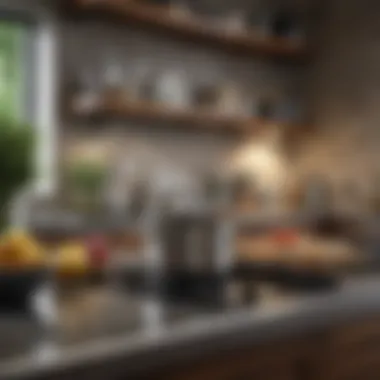
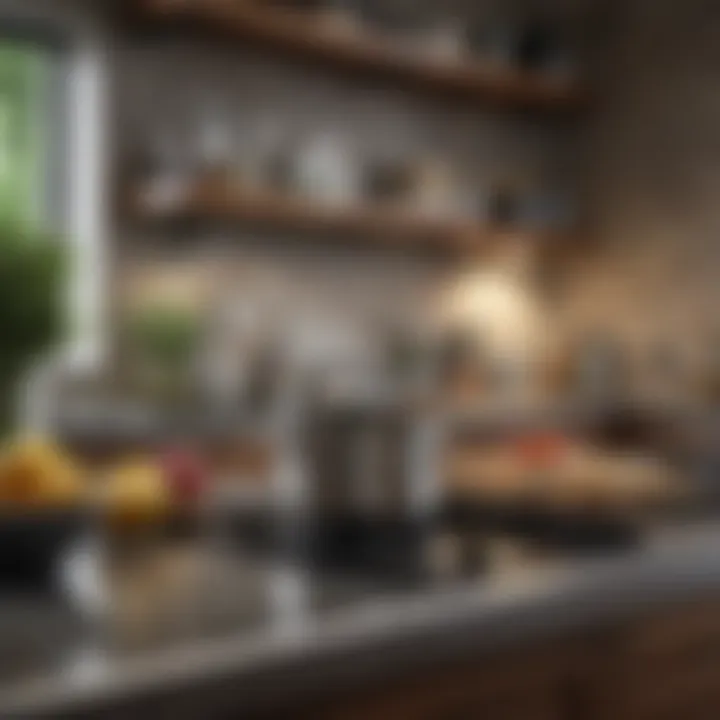
Incorporating decorative elements is a practical and visual strategy to enhance any kitchen space.
Adopting Minimalism
Embracing minimalism in kitchen countertop organization is not just a trend; it is a lifestyle choice that brings several advantages to the culinary space. By focusing on essential items and eliminating distractions, minimalism creates a more functional and visually calm environment. This approach encourages intentionality in kitchen design. Less clutter leads to an efficient workflow, which is critical for those who spend considerable time cooking and entertaining.
The benefits of adopting minimalism include improved accessibility to kitchen tools, time savings during meal preparation, and a cleaner aesthetic that enhances the overall kitchen design. Consider the following key elements when adopting minimalism:
- Prioritize Functionality: Each item on the countertop should serve a purpose. If it does not contribute to cooking or food preparation, consider removing it.
- Create Clear Zones: Designate specific areas for different tasks. For example, keep only the items necessary for food prep in one area.
- Be Mindful of Aesthetics: A minimalist approach should not compromise the visual aspect. Choose a few high-quality items that can also serve as decor.
Adopting minimalism allows for a kitchen that not only looks appealing but also enhances the ease of cooking and entertaining.
Eliminating Clutter
One of the first steps in minimalist kitchen countertop organization is eliminating clutter. This involves evaluating all items currently on the countertop and determining which are essential and which are not. Start by removing everything from the countertop. This creates a clear view of your space and allows for better assessment.
Here are practical steps to effectively eliminate clutter:
- Sort Items: Divide all items into categories: essential, non-essential, and sentimental. Items that do not fit into the essential category should be considered for storage or donation.
- Use Storage Solutions: For items that are still needed but do not end up on the counter, seek functional storage solutions, such as drawers or cabinets. This keeps surfaces open and tidy.
- Regular Reviews: Create a habit of periodically reviewing what is on display to prevent accumulation of unnecessary items overtime.
Effective clutter elimination not only improves the visual appeal of the countertop but also contributes to a more organized and efficient cooking process.
Focusing on Essential Items Only
Focusing on essential items leads to streamlined functionality. Each piece on the countertop should be useful, which maximizes space and reduces the cognitive load during cooking tasks. Assessing the frequency of use for each item will help make informed decisions.
Consider the following when focusing on essential items:
- Evaluate Usage Frequency: Frequently used items, such as knives or mixing bowls, should be easily accessible, while seldom used equipment can be stored away.
- Quality Over Quantity: Invest in high-quality tools that serve multiple purposes, reducing the need for multiple, single-function items. For example, a good chef's knife can accomplish tasks that would otherwise require several tools.
- Invariant Item Selection: Choose a few items that can cover most cooking needs, making it simpler to maintain the organized space.
By concentrating on essential items only, the kitchen remains functional and visually pleasing, ultimately enhancing the cooking experience.
Utilizing Technology for Organization
In today's fast-paced world, the integration of technology into kitchen countertop organization is not just a trend; it is a necessity. Many homeowners find themselves overwhelmed by clutter and disarray. Thankfully, technology offers effective solutions that streamline organization processes and improve functionality. Smart devices and applications can help optimize space while making everyday tasks more manageable.
Smart Storage Solutions
Smart storage devices can transform your kitchen into a more organized and efficient workspace. These products range from modular storage units that maximize space to automated containers that keep food fresh. For instance, smart storage jars can enable you to monitor inventory levels via apps. This ensures you never run out of essential ingredients and allows you to plan meals effectively.
Additionally, adjustable shelving systems that can be controlled via an app can adapt to different kitchen items. You can customize the height and layout whenever necessary, enhancing accessibility while maintaining a neat appearance.
Benefits of Smart Storage Solutions:
- Dynamic Organization: Adapts to changing needs easily.
- Inventory Management: Keeps track of perishable items.
- Space Optimization: Makes full use of available space without sacrificing aesthetics.
Apps for Kitchen Inventory Management
Virtual inventory management apps are invaluable tools for maintaining an organized kitchen. These applications help you catalog items on your countertop and in cabinets. Simply scan barcodes to add items easily. Many apps will send reminders for expiry dates, helping reduce food waste. Popular choices like Pantry Check or Out of Milk stand out for their user-friendly interface and effective tracking capabilities.
Moreover, some apps can generate shopping lists based on your inventory, ensuring you only purchase what you genuinely need. This can be particularly useful for busy homeowners who often multitask.
Key Features to Look For:
- Barcode Scanning: Effortlessly add items to your inventory.
- Expiry Notifications: Helps manage perishable goods effectively.
- Shopping List Creation: Streamlines grocery shopping for added convenience.
"With the right technology, kitchen organization can be transformed, allowing for a more efficient and pleasant cooking experience."
Utilizing technology in the form of smart storage solutions and inventory management apps can lead to a well-organized kitchen that makes cooking and meal preparation less stressful and more enjoyable. As homeowners continue to seek seamless integration of technology in their living spaces, these tools will remain indispensable in maintaining sleek and functional kitchen environments.
Inspiration from Modern Design Trends
Modern design trends provide valuable insight into creating a stylish and functional kitchen countertop. Trends like open shelving and industrial elements not only enhance the aesthetics but also contribute to improved organization and usability. By thoughtfully incorporating these elements into your kitchen, you can reflect contemporary styles while achieving a practical and visually pleasing environment.
Embracing Open Shelving
Open shelving presents itself as a versatile option for kitchen organization. This trend allows homeowners to showcase their kitchenware and curated collections, transforming pragmatic needs into an aesthetic opportunity. Furthermore, open shelves create the illusion of open space, which can be beneficial in smaller kitchens.
When implementing open shelving, consider several factors:
- Material selection: Wood, glass, or metal can emphasize your personal style.
- Weight distribution: Ensure that shelves can support the intended items without sagging or causing damage.
- Accessibility: Place frequently used items at eye level for ease of access.
Open shelving encourages organization through visibility. Since everything is out in the open, it’s easier to keep items tidy and find what you need. However, one must balance aesthetics with functionality to avoid a cluttered appearance.
"Open shelving can be both functional and artistic, but proper organization is key to success."
Incorporating Industrial Elements
Industrial design elements bring a raw, unrefined quality to kitchen spaces. This trend often includes features like metal accents, unfinished wood, and exposed bricks. These materials not only emphasize a contemporary feel but also enhance durability in the kitchen environment.
Here are some reasons to consider integrating industrial elements:
- Robustness: Industrial materials tend to withstand wear and tear better than more delicate options.
- Versatility: This style complements various decor choices, making it easier to blend with existing furnishings.
- Functional design: Elements like wire racks or metal stools reinforce a focus on practicality.
While incorporating industrial elements, strive for balance. Combining softer elements, such as textiles or greenery, can soften the often harsh look of metal and wood combinations. Focusing on harmony ensures the space remains welcoming and functional.
In summary, drawing inspiration from modern design trends, such as open shelving and industrial elements, can radically improve kitchen countertop organization. Adopting these styles not only promotes a sense of order but also reflects current design aesthetics, making your kitchen both practical and pleasing to the eye.
Maintaining Long-Term Organization
Maintaining organization on the kitchen countertop is essential for creating an efficient workspace. This emphasis on long-term organization not only enhances the visual appeal of the kitchen but also boosts functionality. A well-maintained countertop speaks to the homeowner's commitment to a tidy and workable space. Achieving lasting organization involves developing habits and strategies that prevent clutter from accumulating over time. It requires thoughtful consideration of how often items are used, where they are placed, and how easily they can be accessed.
Establishing Routines
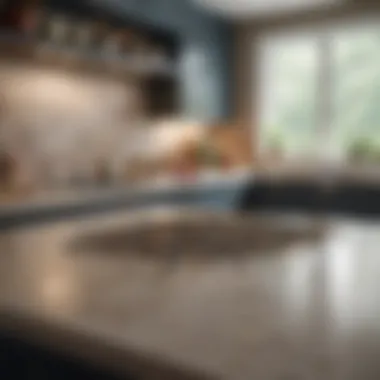
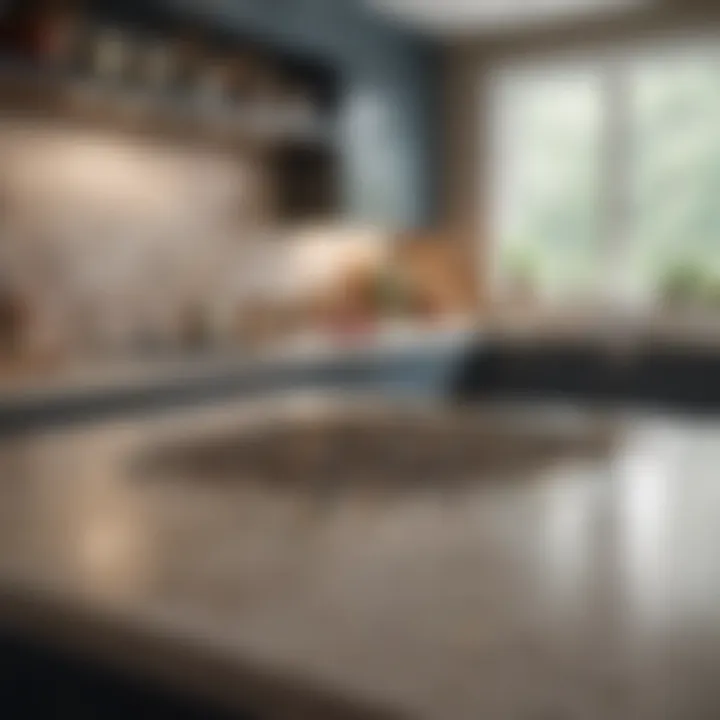
Establishing routines is a fundamental approach to maintaining an organized kitchen countertop. It is about creating a habitual practice that allows for regular tidiness. For instance, setting aside a few minutes each day to put things back in their rightful place can significantly reduce clutter.
- Daily Cleaning: Setting a strict time (maybe after dinner) to clear the countertop can help. This daily ritual ensures that any items used during meal prep or serving don't remain on the surface overnight.
- Weekly Decluttering: Dedicate a bit more time each week to assess what is available on the countertop. Items that are seldom used or not needed can be placed in storage.
- Scheduled Cleaning with Family: If the kitchen is shared among others, including a cleaning schedule can help keep everyone accountable.
The routine should work for your personal lifestyle. Adaptability is key. Keep notice of how your kitchen use shifts over time, and adjust these routines accordingly.
Adapting to New Needs
Adapting to new needs is another critical aspect of long-term organization. With changing lifestyles, the requirements of kitchen space can evolve. This means that what worked before might need reevaluation.
- Assessing Lifestyle Changes: For instance, if a family expands or starts cooking new types of cuisine, consider how items are used. Items may need to shift in accessibility based on the frequency of use.
- Seasonal Considerations: Certain items may be used more during certain seasons. For example, barbecue utensils might take prominence in summer, while baking tools could be more necessary in winter.
In addition, integrating feedback from the family can inform what initiatives work and which don’t. Flexibility is crucial in maintaining a system that serves its purpose well beyond initial implementation.
"The best-organized kitchen is not static; it is something that evolves with the users' needs."
In summary, establishing routines and adapting to new needs allows you not just to keep things in order but also to cultivate an environment that continues to meet practical requirements. By being proactive and attentive to these elements, maintaining long-term organization on the kitchen countertop becomes a feasible pursuit.
Overcoming Common Challenges
The kitchen can often be a focal point in a home, both for functionality and aesthetics. However, it can also present certain challenges, particularly in organization. This section emphasizes the significance of overcoming common obstacles in kitchen countertop organization. Identifying and addressing these issues can significantly improve the flow and utility of this space.
By tackling these challenges, homeowners can create a more efficient and visually appealing kitchen environment. A well-organized countertop supports smoother cooking processes. It also allows for easier access to essential items, reducing stress during meal preparation. Understanding these elements will help individuals optimize their kitchen layouts effectively.
Dealing with Limited Space
Limited space is one of the most pressing issues for many homeowners. In smaller kitchens, every square inch counts. It's crucial to reconsider how items are arranged to make the most of the available area. One useful strategy is to prioritize items based on their use. Frequently used utensils and appliances should be easily accessible.
Consider investing in multi-functional items, such as a coffee maker that can brew in a variety of ways. This approach not only saves space but enhances functionality. Additionally, employing tiered organizers can help take advantage of vertical space on countertops. Compact storage solutions can make a notable difference.
Here are a few specific tips to manage limited space effectively:
- Use drawer organizers for small items like utensils and gadgets.
- Install magnetic strips on walls for knives or spices.
- Stackable containers can maximize cabinet space while keeping things visible.
Managing Frequent Changes in Use
Another challenge is the variability in how the kitchen is used. Families may have different needs on weekdays compared to weekends. Hosting parties or events can further complicate organization. Thus, it becomes essential to create a flexible organization system.
To adapt to changing situations, try to adopt a dynamic storage structure. This might include movable carts or portable storage solutions that can be adjusted based on the current needs. For example, using a kitchen island as a storage space can be effective during gatherings. Afterward, it can be cleared for normal use.
Here are some approaches to consider:
- Utilize clear bins to store items that can be easily accessed and rearranged.
- Create zones for different activities, such as prep work, cooking, and socializing.
- Implement a routine check of countertop organization every few weeks, ensuring it meets your needs.
In summary, overcoming challenges in kitchen countertop organization requires a thoughtful approach tailored to individual needs and lifestyles. By addressing limited space and adapting to frequent changes, homeowners can streamline their kitchens, enhancing both form and function.
Integrating Personal Style
In the world of kitchen organization, integrating personal style is essential. A well-organized countertop not only enhances functionality but also reflects the homeowner’s unique aesthetics. When considering organization, one must think beyond mere practicality. Personal touches can transform a mundane space into one that resonates with the individual’s taste and personality.
Personal style can manifest in various forms, from the choice of colors to the kinds of accessories used. Incorporating elements that resonate with you creates a pleasant cooking environment. Moreover, it makes the kitchen a space where you feel comfortable and inspired.
Reflecting Individual Preferences
Reflecting individual preferences in your kitchen organization is crucial. It provides a sense of ownership and identity that elevates the cooking experience. Everyone has different preferences, influenced by culture, lifestyle, and personal passions. To achieve this, start by assessing what items matter most to you.
Ask yourself these questions:
- What tools do I use most often?
- Are there any sentimental items I want to display?
- How do I wish to feel when I enter my kitchen?
These questions lead to personalized solutions. For example, if you enjoy cooking, prioritize displaying your favorite utensils in a stylish holder. Alternatively, if you appreciate the decor, integrate vintage pieces into your space.
Choosing a Color Palette
Choosing an appropriate color palette is a powerful way to express personal style in kitchen organization. Colors influence mood and can make a kitchen feel vibrant or calm. When selecting colors, consider both your preferences and how they affect your space.
A well-chosen palette can create cohesion within your kitchen, tying together elements like countertops, cabinets, and decor. Some popular palettes include:
- Neutral Tones: They create a calm background, allowing other elements to stand out.
- Bold Colors: A strong hue can energize the space. If you cook frequently, use a color that stimulates creativity.
- Pastels: Soft shades can add warmth and a cozy feel, suitable for informal gatherings.
"A thoughtful color palette is more than decoration; it encapsulates your lifestyle and personal ethos."
Remember, the color choice should not only align with your taste but also complement the kitchen's overall design. A harmonious kitchen enhances both aesthetics and functionality.
Evaluating Your Progress
Evaluating your progress in kitchen countertop organization is a crucial step in maintaining an efficient and aesthetically pleasing workspace. Progress evaluation allows you to understand what organization strategies work well and where improvements can be made.
This process includes reflecting on the layout and accessibility of items on your countertop. It's also about recognizing the efficiency of your cooking and preparation patterns. By regularly assessing your kitchen setup, you can ensure that it remains aligned with your needs.
Assessing Effectiveness
To determine the effectiveness of your kitchen countertop organization, start by asking specific questions. Are you utilizing space efficiently? Can you easily access the items you use most often? Keep a checklist of functionalities that matter most.
- Functionality: Observe if essential items are within reach.
- Clutter Levels: Note if the countertop looks cluttered during meal prep.
- Aesthetic Appeal: Assess if the kitchen appears inviting.
By conducting a self-audit, you can ascertain which elements are successful and which require adjustment.
Making Adjustments as Needed
It is important to make adjustments based on your evaluations. This might mean reorganizing items or adding new storage solutions. When changes feel necessary, consider the following:
- Reorganization: Move frequently used items closer, and relocate seldom used ones out of sight.
- Add Storage Solutions: If space permits, incorporate shelves or hooks. These contribute to better organization.
- Simplicity Focus: Limit the number of items displayed on the countertop to avoid overwhelm.
By thoughtfully adjusting your organization strategy, you can create a kitchen workspace that remains functional and visually appealing, catering to both your culinary needs and personal style.
Progress evaluation is not merely a checklist—it’s an ongoing journey towards a more functional kitchen experience.
Adjusting as you go along will keep your kitchen dynamics fluid and responsive to your lifestyle.



